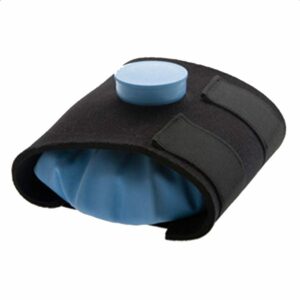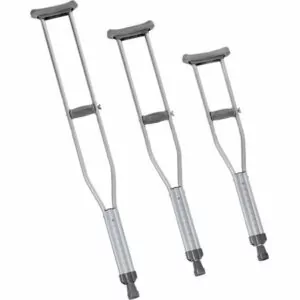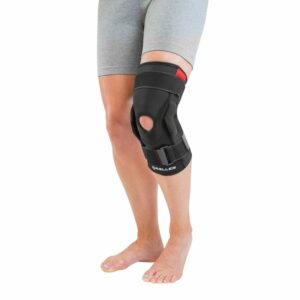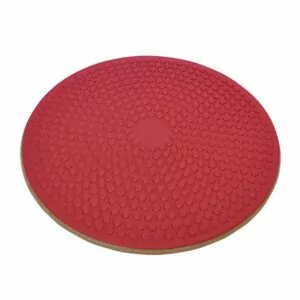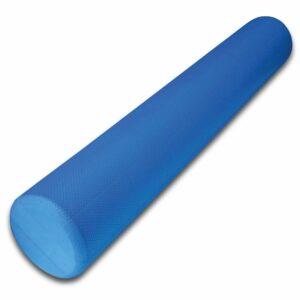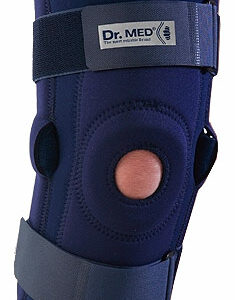ACL Tear
Updated:
(Also known as Anterior Cruciate Ligament Tear, Torn ACL, ACL Sprain, Sprained ACL, ACL Injury, Ruptured ACL)
What is an ACL tear?
An ACL tear is a relatively common sporting injury affecting the knee and is characterized by tearing of the Anterior Cruciate Ligament (ACL), an important stabilizing structure of the knee.
A ligament is a strong band of connective tissue which attaches bone to bone. The ACL is situated within the knee joint and is responsible for joining the back of the distal femur (lower aspect of the thigh bone just above the knee joint) to the front of the proximal tibia (upper aspect of the shin bone just below the knee joint) (figure 1).
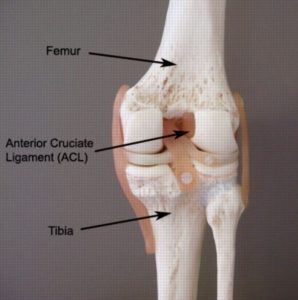
The ACL is one of the most important ligaments of the knee, giving it stability. The ACL achieves this role by preventing excessive twisting, straightening of the knee (hyperextension) and forward movement of the tibia on the femur. When these movements are excessive and beyond what the ACL can withstand, tearing to the ACL occurs. This condition is known as an ACL tear and may range from a small partial tear resulting in minimal pain, to a complete rupture of the ACL resulting in significant pain and disability, requiring comprehensive rehabilitation and potentially surgery. An ACL tear can be graded as follows:
- Grade 1 tear: a small number of fibres are torn resulting in some pain, but allowing full function.
- Grade 2 tear: a significant number of fibres are torn with moderate loss of function.
- Grade 3 tear: all fibres are ruptured resulting in knee instability and major loss of function. With these injuries, other structures are also often injured, such as the menisci or collateral ligaments. Comprehensive rehabilitation is required to return to full sporting activity and often surgery is performed to reconstruct the ligament, and/or repair other structures.
As with all ligament injuries in the knee, ACL tears tend to occur more frequently in female athletes compared to males.
Causes of an ACL tear
ACL tears typically occur during activities placing excessive strain on the ACL. This generally occurs suddenly due to a specific incident, however, occasionally may occur due to repetitive strain. There are three main movements that place stress on the ACL, these include:
- twisting of the knee
- hyperextension of the knee
- forward movement of the tibia on the femur
When any of these movements (or combinations of these movements) are excessive and beyond what the ACL can withstand, tearing of the ACL may occur. Of these movements, twisting is the most common cause of an ACL tear.
ACL tears are frequently seen in contact sports or sports requiring rapid changes in direction (pivoting). These may include: football, netball, basketball and downhill skiing. The usual mechanism of injury for an ACL tear is a twisting movement (change of direction) when weight-bearing (especially when landing from a jump) or due to a collision forcing the knee to bend in the wrong direction (such as another player falling across the outside of the knee). Occasionally an ACL injury may occur during a sudden deceleration when running.
Signs and Symptoms of an ACL tear
Patients withan ACL tearmay notice an audible snap or tearing sound at the time of injury. In minor cases of an ACL tear, patients may be able to continue activity only to experience an increase in pain, swelling and stiffness in the knee after the activity, with rest (particularly the next morning). Often the pain associated withthis conditionis felt deep within the knee and is poorly localized.
In cases of a complete rupture of the ACL, pain is usually severe at the time of injury, however, may sometimes quickly subside. Patients may also experience a feeling of the knee going out and then going back in, as well as a rapid onset of considerable swelling (within the first few hours following injury). Patients with a complete rupture of the ACL generally cannot continue activity as the knee may feel unstable, or may collapse during certain movements (particularly twisting). Occasionally, the patient may be unable to weight bear at the time of injury due to pain and may develop bruising and knee stiffness over the coming days (especially an inability to fully bend or straighten the knee). Patients with a complete rupture of the ACL may also experience recurrent episodes of the knee giving way following the injury.
Diagnosis of an ACL tear
A thorough subjective and objective examination from an experienced physiotherapist is usually sufficient to diagnose an ACL tear. Investigations, such as an X-ray and MRI scan, are usually required to confirm diagnosis and determine the extent of damage or involvement of other structures within the knee.
Treatment for an ACL tear

Members Only ContentBecome a PhysioAdvisor Member to gain full access to this exclusive content. For more details see Become a Member. Already a member? Login Now
Surgery for an ACL tear
Surgical reconstruction of the ACL is often performed on patients who have a complete rupture of the ACL (particularly those with ongoing episodes of instability or giving way) and who are seeking the highest level of function. The procedure is known as an ACL reconstruction and generally comprises of arthroscopic surgery to reconstruct or repair the ACL with other tissue from your body. The hamstring tendon or patella tendon are most frequently used in this process.
Following ACL reconstruction surgery a lengthy period of rehabilitation of 6-12 months or longer is typically required to gain an optimal outcome and return the patient to full activity or sport. Surgery for an ACL tear is often considered in patients who have a completerupture and:
- are < 40 years of age
- need a high level of knee function for recreational, work or sporting activity
- have associated damage to their menisci or collateral ligaments of the knee
- are able to comply and commit to intensive rehabilitation
- have ongoing knee pain, locking, swelling or recurrent episodes of the knee giving way despite appropriate rehabilitation
In those patients who undergo surgical intervention,rehabilitation should commence from the time of injury, not from the time of surgery. This is essential to minimize swelling, improve range of movement and strength and ensure an optimal outcome following surgery.
Patients who chose not to have surgery to repair their ACL can still have a very good outcome with physiotherapy and rehabilitative exercises alone. Some may experience ongoing knee instability or recurrent episodes of the knee collapsing or giving way, in which case the option of delayed ACL surgery can then be considered.
It is important to note, that patients who chose not to have surgery and those who do undertake surgery both have an increased risk of developing early onset knee osteoarthritis.
Prognosis of an ACL tear
With appropriate management, most patients with a minor to moderate ACL tear (grades 1 and 2) can return to sport or normal activity within 2 – 8 weeks. Patients with a complete rupture of the ACL will require high quality rehabilitation (regardless of whether surgery is undertaken or not). With physiotherapy and rehabilitation exercises alone (i.e. no surgery) most patients will be able to return to sport within 2-6 months. In those patients who undertake ACL reconstructive surgery, a lengthy period of rehabilitation (6-12 months or longer) is typically required to gain optimal function. Patients who also have damage to other structures of the knee such as the meniscus or collateral ligaments are likely to have an extended rehabilitation period.
Contributing factors to an ACL tear
There are several factors which can increase the risk of sustaining of an ACL injury. These factors need to be assessed and (where possible) corrected with direction from a physiotherapist. Some of these factors include:
- sex (more common in females)
- past history of a previous ACL injury (in either knee)
- lower limb posture (increased Q angle, genu valgum, pronated feet)
- muscle tightness (particularly hip adductors, hip flexors, quadriceps or calf)
- muscle weakness (particularly the quadriceps (VMO), hamstrings or hip abductors/external rotators)
- muscle strength imbalances (decreased hamstring to quadriceps ratio)
- poor pelvic or core stability
- poor coordination or jumping and landing strategies
- joint stiffness (particularly the ankle or hip)
- inadequate rehabilitation following a previous ACL injury
- abnormal running biomechanics/technique
- inappropriate footwear or surfaces
- being overweight, deconditioned or fatigued
- generalized ligament laxity (hypermobile)
- pregnancy (increased ligament laxity)
- mid menstrual cycle (increased risk at ovulation due to hormonal changes causing increased ligament laxity)
Physiotherapy for an ACL tear
Physiotherapy for patients withthis conditionis vital to hasten the healing process, ensure an optimal outcome and reduce the likelihood of future recurrence. Treatment may comprise:
- exercises to improve flexibility, strength, lower limb balance and control
- soft tissue massage
- joint mobilization
- dry needling
- electrotherapy (e.g. ultrasound)
- taping
- bracing
- the use of crutches
- ice or heat treatment
- anti-inflammatory advice
- hydrotherapy
- education
- activity modification advice
- biomechanical correction
- a gradual return to running program
- a gradual return to sport or activity program
Other intervention for an ACL tear
Despite appropriate physiotherapy management, a small percentage of patients with a minor to moderate ACL tear and some patients with a complete ACL tear do not improve adequately. When this occurs the treating physiotherapist or doctor can advise on the best course of management. This may involve further investigation such as an X-ray, CT scan or MRI, or a review by a specialist who can advise on any procedures that may be appropriate to improve the condition. Surgical reconstruction of the ACL may be required particularly when conservative measures fail.
Exercises for an ACL tear
The following exercises are commonly prescribed to patients with an ACL tear. You should discuss the suitability of these exercises with your physiotherapist prior to beginning them. Generally, they should commence once the physiotherapist has indicated it is safe to do so and only provided they do not cause or increase symptoms.
Your physiotherapist can advise when it is appropriate to begin the initial exercises and eventually progress to the intermediate and advanced exercises. As a general rule, addition of exercises or progression to more advanced exercises should take place provided there is no increase in symptoms.
Initial Exercises
These initial exercises should generally be performed 3 times daily:
Knee Bend to Straighten
Begin this exercise by lying on your back as demonstrated (figure 2). Bend and straighten your knee as far as you can go without pain and provided you feel no more than a mild to moderate stretch. Repeat 10 – 20 times.
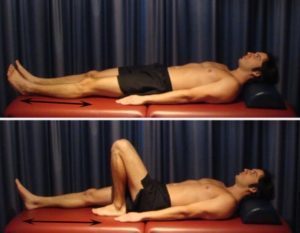
Static Quadriceps Contraction
Begin this exercise in the position demonstrated (figure 3). Tighten the muscle at the front of your thigh (quadriceps) by pushing your knee down into a towel. Put your fingers on your inner quadriceps (VMO) to feel the muscle tighten during contraction. Hold for 5 seconds and repeat 10 times as hard as possible provided the exercise does not cause or increase your symptoms.
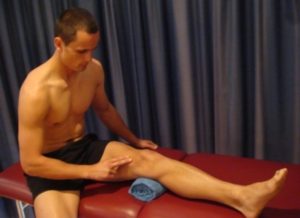
Static Hamstring Contraction
Begin this exercise in sitting with your knee bent to about 45 degrees. Press your heel into the floor tightening the back of your thigh (hamstrings). Hold for 5 seconds and repeat 10 times as hard as possible provided the exercise does not cause or increase your symptoms.
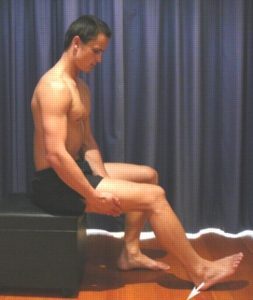
Intermediate Exercises

Members Only ContentBecome a PhysioAdvisor Member to gain full access to this exclusive content. For more details see Become a Member. Already a member? Login Now
Advanced Exercises

Members Only ContentBecome a PhysioAdvisor Member to gain full access to this exclusive content. For more details see Become a Member. Already a member? Login Now
Other Exercises

Members Only ContentBecome a PhysioAdvisor Member to gain full access to this exclusive content. For more details see Become a Member. Already a member? Login Now
Rehabilitation Protocol for an ACL Tear

Members Only ContentBecome a PhysioAdvisor Member to gain full access to this exclusive content. For more details see Become a Member. Already a member? Login Now
 Physiotherapy products for an ACL tear
Physiotherapy products for an ACL tear
Some of the most commonly recommended products by physiotherapists to hasten healing and speed recovery in patients with an ACL tear include:
To purchase physiotherapy products for an ACL tear click on one of the above links or visit the PhysioAdvisor Shop.
 Find a Physio for an ACL tear
Find a Physio for an ACL tear
Find a physiotherapist in your local area to treat an ACL tear.
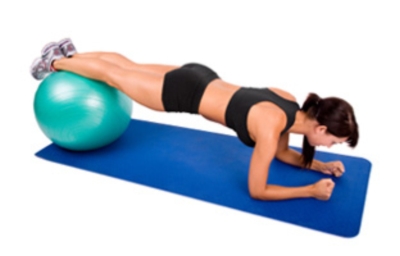 More Exercises
More Exercises
- Knee Stretches
- Knee Strengthening Exercises
- Leg Strengthening Exercises
- Leg Stretches
- Lower Body Machine Weights
- Balance Exercises
- Cardiovascular Exercise
- Core Stability Exercises
- Pilates Exercises
 Recommended Reading
Recommended Reading
- Ice or Heat
- The R.I.C.E. Regime
- Choosing a Shoe
- Do I Need Orthotics?
- How to use Crutches
- Knee Taping
- Patella Taping
- Return to Running
- Return to Sport
- Warming up and Cooling Down
- Injury Prevention
- Knee Diagnosis Guide
Become a PhysioAdvisor Member
-
 Individual Membership (12 Months)$59.95 for 1 year
Individual Membership (12 Months)$59.95 for 1 year -
 Individual Membership (3 Months)$39.95 for 3 months
Individual Membership (3 Months)$39.95 for 3 months -
 Individual Membership (Yearly)$49.95 / year
Individual Membership (Yearly)$49.95 / year -
 Individual Membership (Monthly)$15.95 / month
Individual Membership (Monthly)$15.95 / month

Link to this Page
If you would like to link to this article on your website, simply copy the code below and add it to your page:
<a href="https://physioadvisor.com.au/injuries/knee/acl-tear”>ACL Tear – PhysioAdvisor.com</a><br/>An ACL tear is a sporting injury affecting the knee and is characterised by tearing of the Anterior Cruciate Ligament. Explore its causes, treatment & exercises now.
Return to the top of ACL Tear.

